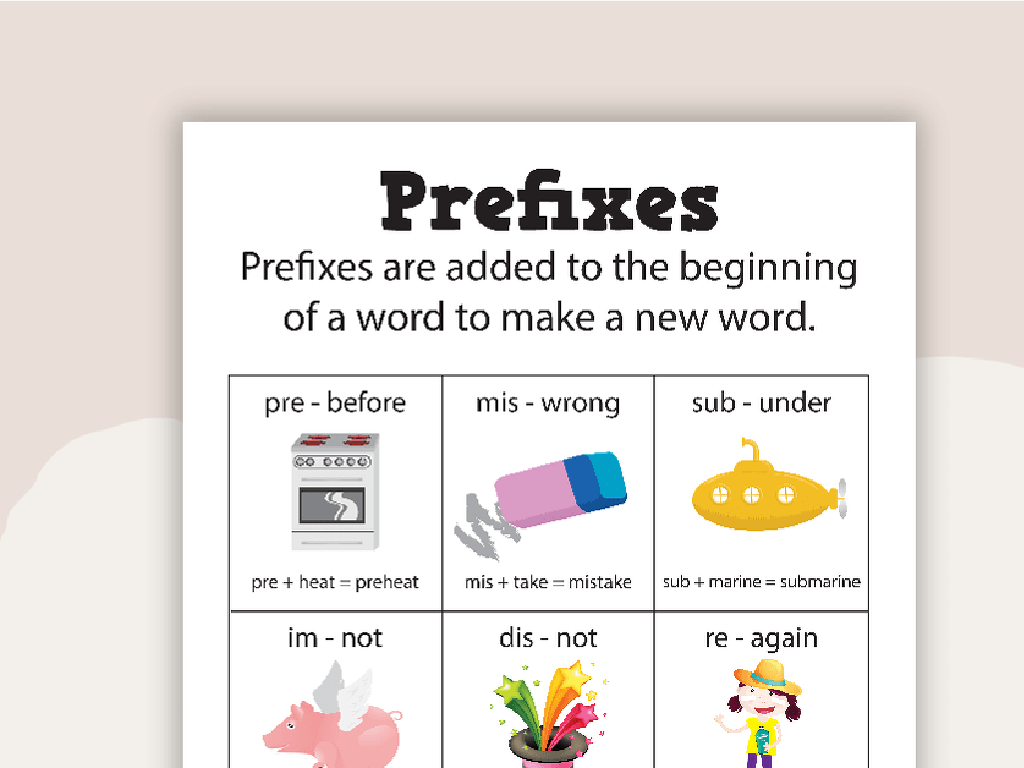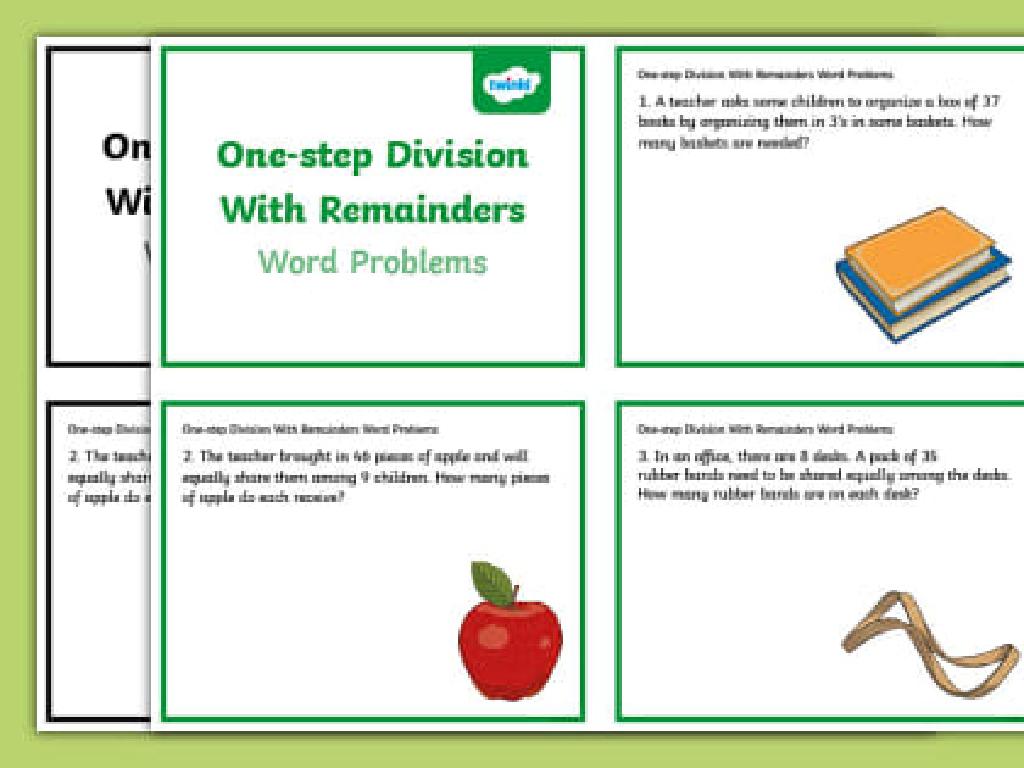Abbreviate Metric Units Of Measurement
Subject: Language arts
Grade: Third grade
Topic: Abbreviations
Please LOG IN to download the presentation. Access is available to registered users only.
View More Content
Introduction to Abbreviations
– What are abbreviations?
– Shortened forms of words or phrases
– Why use abbreviations?
– To save time and space in writing
– Examples in daily life
– e.g., Dr. for Doctor, Jan. for January
– Practice with metric units
– Learn to abbreviate meters (m), liters (L), and grams (g)
|
This slide introduces the concept of abbreviations to third-grade students, explaining that abbreviations are shorter versions of words or phrases used to save time and space, especially when writing. It’s important to provide examples that are relevant to their everyday experiences, such as abbreviations they might see on a calendar or when referring to a professional title. After discussing the purpose and common examples, transition to the specific topic of metric units, which they will encounter in math and science. Encourage students to think of other abbreviations they know and use this knowledge to understand how to abbreviate metric units like meters, liters, and grams. This will set the foundation for more in-depth learning about measurement and its abbreviations.
Metric Units and Their Abbreviations
– What are Metric Units?
– Standard units for measuring things
– Common Units: m, l, g
– Meter (m) for length, Liter (l) for volume, Gram (g) for weight
– Daily life uses of Metric Units
– Cooking, weather reports, buying groceries
|
This slide introduces students to the concept of metric units, which are a standard set of measurements used around the world. Explain that ‘m’ stands for meter, which measures length, ‘l’ for liter, which measures volume, and ‘g’ for gram, which measures weight. Provide examples of where they might encounter these units in daily life, such as following a recipe for cooking (liters and grams), checking the temperature (degrees Celsius), or measuring their height (meters). Encourage students to think of other examples and to notice these units in their surroundings to reinforce their understanding.
Abbreviating Metric Units
– Learn to abbreviate metric units
– Meter to ‘m’, Liter to ‘l’, Gram to ‘g’
– These are shorter ways to write measurements
– Practice: Kilometer to ‘km’
– ‘Kilometer’ is a long way, we write it ‘km’
– Practice: Milliliter to ‘ml’, Kilogram to ‘kg’
– ‘Milliliter’ measures liquid, ‘ml’ and ‘Kilogram’ for weight, ‘kg’
|
This slide introduces students to the concept of abbreviating metric units, which is a way to write measurements in a shorter form. Start by explaining that just like nicknames make names shorter, we can also make the names of measurements shorter. Show how ‘Meter’ becomes ‘m’, ‘Liter’ becomes ‘l’, and ‘Gram’ becomes ‘g’. Then, engage the class with practice examples, asking them to abbreviate ‘Kilometer’, ‘Milliliter’, and ‘Kilogram’. Use objects or visuals to help them understand the context of each unit – such as a meter stick, a water bottle, and a bag of flour. Encourage the students to come up with other examples of things that might be measured in kilometers, milliliters, and kilograms. This will help them remember the abbreviations better.
Abbreviating Metric Units
– No periods in metric abbreviations
– Capitalize names from people
– For Kelvin, we use ‘K’ not ‘k’
– Use abbreviations in sentences
– ‘The water is 20 liters’ becomes ‘The water is 20 L’
– Practice with examples
– Find examples in classwork and homework
|
This slide introduces the rules for abbreviating metric units, which is an important skill in both science and math. Emphasize that unlike abbreviations in general English, metric unit abbreviations do not use periods. Highlight that units named after people are capitalized to honor their namesakes, such as Kelvin (K), and demonstrate how to correctly use these abbreviations within sentences. Provide practice opportunities through classwork and homework to reinforce these concepts. Encourage students to always check their work for correct abbreviation usage.
Let’s Practice Abbreviating Metric Units!
– Worksheet: Match units and abbreviations
– Group Activity: Measure classroom items
– Work together to find and measure items
– Use correct abbreviations
– Remember to write ‘cm’, ‘m’, ‘L’ for centimeters, meters, liters
– Share findings with the class
|
This slide introduces two engaging activities to help students practice abbreviating metric units of measurement. For the worksheet, provide a list of metric units alongside their abbreviations and ask students to draw lines to match them correctly. In the group activity, students will collaborate to find various items in the classroom, measure them, and then write down their measurements using the correct abbreviations. This hands-on approach reinforces their understanding of metric units and their abbreviations. After the activities, encourage students to share their findings, fostering a collaborative learning environment. Possible items to measure could include a book (cm), the length of a desk (m), or the volume of a water bottle (L).
Class Activity: Abbreviation Scavenger Hunt
– Find and measure classroom objects
– Write measurements with abbreviations
– Use abbreviations like cm for centimeters, m for meters
– Share findings with the class
– Discuss the usefulness of abbreviations
– Abbreviations save time and space in writing
|
This activity is designed to help students understand and practice using abbreviations for metric units of measurement. Students will search the classroom for items to measure, such as a desk or book, and then record their measurements using the appropriate abbreviations (e.g., cm, m, kg). Afterward, they will present their findings to the class, fostering public speaking and sharing skills. The discussion on the usefulness of abbreviations should highlight how they make communication more efficient, especially in science and math. Possible variations of the activity could include measuring the same object with different units, comparing measurements, or even creating a display of their findings on a classroom ‘measurement wall’.
Metric Units Abbreviations: Recap & Quiz
– Recap on metric unit abbreviations
– Quick Quiz: Abbreviate 10 units
Examples: Kilometer (km), Liter (L), Gram (g)
– Importance of knowing abbreviations
Helps in science, math, and following recipes
– Review and closing thoughts
|
As we conclude, let’s review the abbreviations for metric units of measurement. Remind the students of the common units like meters (m), liters (L), and grams (g), and how we use shorter forms to make writing and reading easier. Conduct a quick quiz to reinforce learning, asking students to write abbreviations for ten different metric units. Discuss why it’s important to know these abbreviations: they are widely used in various subjects, especially in science and math, and are also essential for understanding recipes in cooking. Encourage students to practice these abbreviations at home to become more familiar with them.






